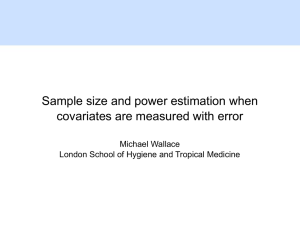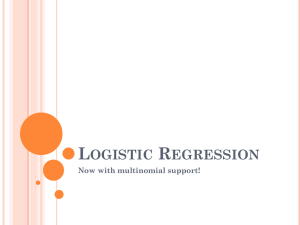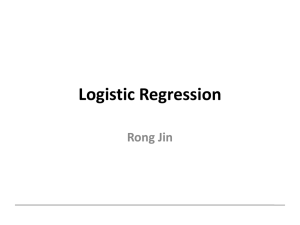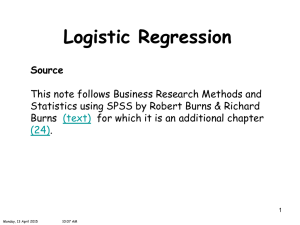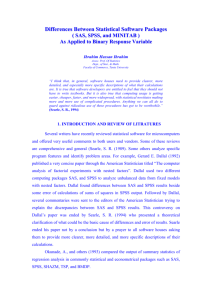Logistic regression in SPSS
advertisement
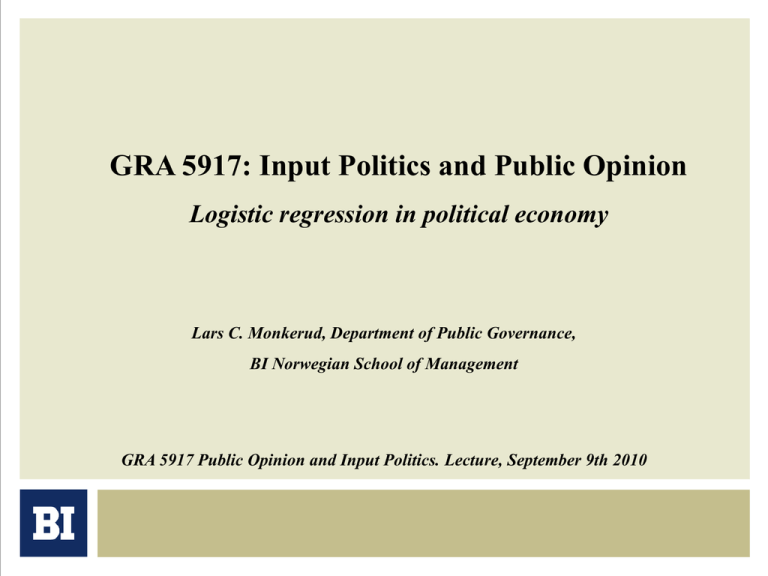
GRA 5917: Input Politics and Public Opinion Logistic regression in political economy Lars C. Monkerud, Department of Public Governance, BI Norwegian School of Management GRA 5917 Public Opinion and Input Politics. Lecture, September 9th 2010 First, though: Interaction effects in basic regression analysis (from last week)… • Given the model… y 0 A X A B X B AB X A X B e …simple rearrangment yields y 0 ( A AB X B ) X A B X B e or y 0 ( B AB X A ) X B A X A e that is… y / X A A AB X B or y / X B B AB X A Interaction effects in basic regression analysis • Model with interaction terms… …entails symmetry: Effect of one variable contingent on the other and vice versa …terms are mostly not to be interpreted in isolation: A effect of XA when XB=0 (but, consider centering of variables to rescale an interesting value of XB to 0); AB tells whether effect of XA (XB) on Y depends on XB (XA) for some values of XB (XA) …additive terms are not to be seen as unconditional effects; little sense in asking of effect of Xk in general Interaction effects in basic regression analysis • In model with interaction terms both the effect and… …the significance of the effect of one varaible varies with value of other variable: var(y / X A ) var( A ) var( AB ) X B2 cov( A , AB ) 2 X B that is… se(y / X A ) var(y / X A ) , with CI y / X A t se(y / X A ) Interaction effects in basic regression analysis • Need estimated variances and covariances. In SPSS: Click statistics Request variancecovariance matrix Interaction effects in basic regression analysis • Variance-covariance matrix: XA XB XC XA XB XC var(X A ) cov(X B , X A ) cov(X C , X A ) cov(X A , X B ) var(X B ) cov(X C , X B ) cov(X A , X C ) cov(X B , X C ) var(X C ) Interaction effects… an example: Government duration • govdur: Average duration of governments in parliamentary systems after WWII (in months), • PS: Average parliamentary support as a percentage of seats held in the assembly, • NP: Average number of parties in the government coalition, • PD: A measure of party discipline… in the following model: govdur 0 NP NP PS PS NPPS NP PS PD PD e Interaction effects… an example: Government duration govdur 0 NP NP PS PS NPPS NP PS PD PD e 1) in SPSS dataset gvmnt_duration.sav (downloaded from It’s Learning) create interaction variable NPPS (Transform > Compute Variable). Output descriptive statistics (max., min., mean) for the variables in the dataset 2) run a regression (Analyze > Regression > Linear) with the model and request Covariance matrix under Statistics Interaction effects… an example: Government duration Estimates of k Estimates of variances and covariances Interaction effects… an example: Government duration 3) in a spreadsheet (Excel) use estimates (B) to map expected marginal effects of increasing the number of parties (NP) as it depends on reasonable (i.e. observed) values for parliamentary support (PS): govdur/ NP NP NPPS PS and covariances and an appropriate t-value to find confidence intervals for the effect at different values of PS: t var( NP ) var( NPPS ) PS 2 cov( NP , NPPS ) 2 PS 20 15 10 5 marginal effect of 0 NP on gvmnt. duration (solid -5 line), 95% CI -10 (broken lines) -15 -20 -25 40 50 60 PS 70 80 Excercise (I) 1) Download the social_welfare.sav file for It’s Learning (under today’s lecture). To see whether gender and partisanship are substitutes or (complements) when it comes to explaining factors influencing views on the social welfare-state you run the following regression: socwel 0 R Republican F Female RF Republican Female e What is the difference in attitudes between females and males within the Democratic party? And within the Republican party? Are diffrences significantly greater in the one party as compared to the other? Use the results from the regression to map expected gender differences and their (95%) confidence intervals. Excercise (II) 1) Under today’s lecture on It’s Learning download the lr_md2.sav data that combines the left-right self placement median etsimate from the 1990s with Persson and Tabellini’s economic and institutional data (the 85cross…sav). Construct interaction terms between the LR estimate (md_est) and the institutional indicators (propres2, majpar2 etc.) and perform a regression where you include these intarction terms. Analyze the effect of changing from a proportional parliamentary system to a majoritarian parliamentary system as the electorate’s ideological position changes (a la Gable and Hix (2005; figure2)). Compare the results to G&H’s original result. Logistic regression • Appropriate for categorical dependent variables, e.g. ”yes” vs. ”no” responses, voting for party X or not, acheiving an MSc degree or not, etc…. • A popular model for the simple binary response (1=sucess vs. 0=failure) is the binary Logit model: P Logit L log 0 k X k 1 P … where P is the probability of y=1 (”success” or ”yes”, say) Logistic regression • Wheras L may vary between ∞ and - ∞, it is easily seen that P (reasonably) stays within the 0-1 range: eL e P log 1 P P 1 P eL P 1 eL i.e. the odds of ”success” vs. ”failure”; e is the odds-ratio (OR) Logistic regression • Intuitively appealing since P=f(Xk) increases in L as factor Xk changes, but slowly initially and as P approaches 1: 1 0.9 0.8 0.7 0.6 P 0.5 0.4 0.3 0.2 0.1 0 L(X) Logistic regression in SPSS Choose Analyze > Generalized Linear Models Logistic regression in SPSS Choose Binary logistic Logistic regression in SPSS Choose dependent variable Choose reference category, i.e. to model P(not in ref. category) Logistic regression in SPSS Choose predictors: class variables (factors) or contiuous variables (covariates) Logistic regression in SPSS Build model Presenting changes in P(y=1) from logistic regression results Have estimated L=0.4+1.2·X for X ranging from -4 to 10 Presenting changes in P(y=1) from logistic regression results Have estimated L=0.4+1.2·X for X ranging from -4 to 10




